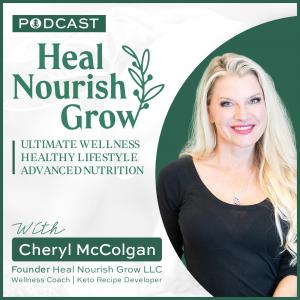Heal Nourish Grow Podcast

Importance of HRV for Longevity and Performance
Don Moxley shares his journey from being a collegiate athlete to becoming a sports scientist and working in the cannabis industry. He emphasizes the importance of movement, strength, energy production, and resilience in both athletic performance and longevity. Don also explains the importance of heart rate variability (HRV) and its relationship to overall health and mortality. He highlights the value of wearing a heart rate monitor and understanding different heart rate zones for optimal training. He shares his experience with HRV and how it can be used to assess cardiovascular health and resilience. Ways to improve HRV include lowering inflammation, improving cardiovascular fitness, optimizing sleep, and managing trauma and stress to improve HRV. We also touched on autophagy and the role of spermidine in longevity. The best way to reach Don is on LinkedIn. He is also on X(Twitter) and Instagram. Spermadine Life and ModeMethod are products he mentioned. Takeaways Movement, strength, energy production, and resilience are key factors in athletic performance and longevity. Heart rate variability (HRV) is highly related to mortality and overall health. It's a key indicator of health and performance. Wearing a heart rate monitor and understanding heart rate zones can optimize training and improve performance. Micronutrients play a crucial role in longevity and should be considered alongside macronutrients. Exercise enhances the endocannabinoid system and brain function, leading to a longer and healthier life. Lowering inflammation, improving cardiovascular fitness, optimizing sleep, and managing trauma and stress can improve HRV. Autophagy is essential for cellular health and longevity. Spermidine is a compound that promotes autophagy and can be obtained from certain foods. Industrialized food may be deficient in essential micronutrients, highlighting the importance of a balanced diet and supplementation. Watch on YouTube: Show Transcript Cheryl McColgan (00:00.43)Hi everyone, welcome back to the Heal Nourish Grow podcast. Today I am joined by Don Moxley and we just had a lovely little pre -interview chat all about our things in common. Don went to The Ohio State University, was a collegiate athlete and is currently traveling around in RV, which if anybody that's listened to this podcast before or read my blog will go back to the little thing that I call the Vegabond adventure. We did that for a little bit in a suburban, not an RV. But so lots in common, but… What I'm really excited about is Don knows so many things about health and wellness and sports performance. And he's got some awesome things to share with us today. But before we go into all that, Don, if you could just share a little bit, I shared briefly about your background, but if you could go into some detail and, you know, how did you get into this work? What makes you passionate about health and wellness and what you're doing today? Don Moxley (00:50.472)That's a, it's a great question. And it's, and, and literally you can't separate the journey from the destination. It's so, I grew up, share, I grew up in Eastern Ohio. We grew up in the strip pits over in Belmont County and I had every intention. I was a decent high school wrestler. I was, you know, I qualified for the state tournament twice, but never want to match there. But when I went to Ohio state with every intention of going home and feeding beef, Cabo for the rest of my life. But. Cheryl McColgan (00:56.558)I'm sorry. Don Moxley (01:19.08)I got to Ohio State, I was good enough to walk on the wrestling team, but it was a struggle. I was injured all the time. And I was one of those wrestlers that used to cut a lot of weight. I cut from 220 to 177 and hence the injury problems. But when I finally, you know, I was injured my sophomore year, I'm thinking, okay, what do I have to do to finally get going?






 Visit Podcast Website
Visit Podcast Website RSS Podcast Feed
RSS Podcast Feed Subscribe
Subscribe
 Add to MyCast
Add to MyCast